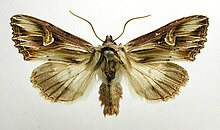Clay is a material primarily composed of a grouping of clay minerals, and can be used as an art medium.

The Noctuidae, commonly known as owlet moths, cutworms or armyworms, are a family of moths. They are considered the most controversial family in the superfamily Noctuoidea because many of the clades are constantly changing, along with the other families of the Noctuoidea. It was considered the largest family in Lepidoptera for a long time, but after regrouping Lymantriinae, Catocalinae and Calpinae within the family Erebidae, the latter holds this title now. Currently, Noctuidae is the second largest family in Noctuoidea, with about 1,089 genera and 11,772 species. This classification is still contingent, as more changes continue to appear between Noctuidae and Erebidae.

Noctuoidea is the superfamily of noctuid or "owlet" moths, and has more than 70,000 described species, the largest number of any Lepidopteran superfamily. Its classification has not yet reached a satisfactory or stable state. Since the end of the 20th century, increasing availability of molecular phylogenetic data for this hugely successful radiation has led to several competing proposals for a taxonomic arrangement that correctly represents the relationships between the major lineages.

Catocala is a generally Holarctic genus of moths in the family Erebidae. The genus was erected by Franz von Paula Schrank in 1802. The moths are commonly known as underwing moths or simply underwings. These terms are sometimes used for a few related moths, but usually – especially when used in plural, not as part of a species name – they are used to refer to Catocala only.

The Noctuinae are a subfamily of the family Noctuidae, and is composed of moths. The larvae of many species feed on roots or stems of various grasses. Some are generalist feeders which makes them potential pests.

Amphipyrinae is a subfamily of owlet moths in the family Noctuidae. There are more than 50 genera and 210 described species in Amphipyrinae, although the classifications are likely to change over time.

Hadenini is a tribe of cutworm or dart moths in the family Noctuidae. There are more than 140 genera and 1,000 described species in Hadenini, found worldwide.

The Apameini are a mid-sized tribe of moths in the Noctuinae subfamily.

The Eriopygini are a small-sized tribe of moths in the Noctuinae subfamily. It was formerly placed in the Hadeninae subfamily.

The Orthosiini are a mid-sized tribe of noctuid moths in the subfamily Noctuinae. The tribe was erected by Achille Guenée in 1837. It was previously included in the former subfamily Hadeninae before being moved.
Janseodes is a monotypic moth genus of the family Erebidae erected by Pierre Viette in 1967. Its only species, Janseodes melanospila, was first described by Achille Guenée in 1852. It is found in India, South Africa and the US state of Florida.

Diparopsis is a genus of moths of the family Noctuidae, subfamily Hadeninae. It includes D. castanea, which is the type species and, known as the "red bollworm", is a significant pest of cotton crops in Africa.

Eupsilia is a genus of moths of the family Noctuidae.
Leucania herrichii is a species of moth in the family Noctuidae. It was described by German entomologist Gottlieb August Wilhelm Herrich-Schäffer in 1849 as Mythimna herrichii. It can be found in Bulgaria, Croatia, Cyprus, Egypt (Sinai), Greece, Iran, Israel, Italy (Sicily), Jordan, Lebanon, Palestine, Syria, Turkey, and Turkmenistan. Adults have a wingspan of approximately 30–36 mm (1.2–1.4 in), and the larvae likely feed on grasses.
Diarsia dimorpha is a moth of the family Noctuidae. It is endemic to Luzon and has also been found in Borneo.
Diarsia gaudens is a moth of the family Noctuidae. It is endemic to Java.
Chaetaglaea fergusoni, or Ferguson's sallow moth, is a moth in the family Noctuidae. It was described by Vernon Antoine Brou Jr. in 1997 and is found in North America.
Homorthodes dubia is a species of cutworm or dart moth in the family Noctuidae. It was described by William Barnes and James Halliday McDunnough in 1912 and is found in North America.

Tesagrotis corrodera is a species of cutworm or dart moth in the family Noctuidae. It was described by Smith in 1907 and is found in North America.












